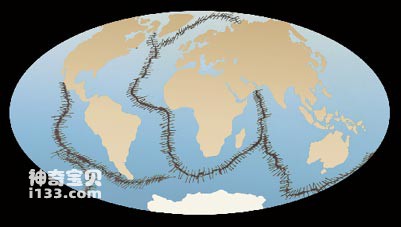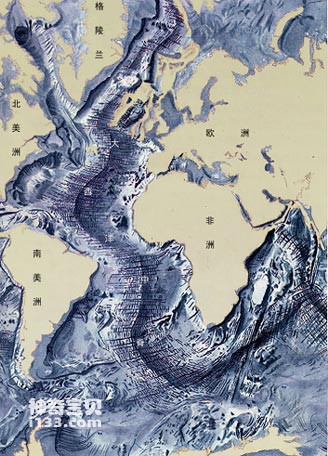People have backbones, and ships have keels. This is an important pillar for people and boats to take a certain shape. Therefore, people can stand between heaven and earth, and ships can sail on the ocean. The ocean also has a backbone, and the backbone of the ocean is the mid-ocean ridge, which determines the growth of the ocean.

Diagram of global mid-ocean ridges
In 1873, scientists on the "Challenger" were conducting oceanographic surveys in the Atlantic Ocean. When measuring the water depth with an ordinary side depth hammer, they discovered a strange phenomenon. The water depth in the middle of the Atlantic Ocean was only about 1,000 meters, but it was deeper than the two oceans. The sides are much shallower. This was beyond their expectations. According to general reasoning, the farther toward the center of the ocean, the deeper it should be. In order to dispel this doubt, they measured a few more points, and the result was still the same. They recorded this fact in the record. From 1925 to 1927, the German survey ship "Meteor" used an echo sounder to conduct detailed measurements of the water depth of the Atlantic Ocean, and drew a nautical chart, which confirmed that there is a mountain range running from north to south in the middle of the Atlantic Ocean. This discovery shocked people at the time and attracted more scientists to investigate. Constantly supplementing and enriching the understanding of it, this huge mountain range in the middle of the Atlantic Ocean is like its backbone, so it is named "Mid-Atlantic Ridge".

Map of the Mid-Atlantic Ridge
The peaks of the Mid-Atlantic Ridge are zigzag-shaped, distributed in the middle of the Atlantic Ocean, roughly parallel to the east and west coasts, and running in an "S" shape from north to south. Starting from Iceland near the Arctic Circle, it winds and twists to 40 degrees south latitude, with a length of 17,000 kilometers and a width of about 1,500 to 2,000 kilometers, accounting for about one-third of the Atlantic Ocean. Its height varies greatly, with many places being more than 5,000 meters above the seafloor. Its average height is about more than 3,000 meters. The part above the sea becomes an island. For example, Iceland is a part of the mid-ocean ridge above the water. Such a huge mountain range is unmatched by any mountain range on land. What is even more peculiar is that at the peak of the mid-ocean ridge, there is a narrow graben along the axis, called the central rift valley, which is about 30-40 kilometers wide and 1000-3000 meters deep. It divides the peak of the mid-ocean ridge into two parallel rows of ridge peaks.
Many observations have shown that earthquakes often occur in the Central Rift Valley area, and heat is often released. This is the weakest point in the earth's crust, where the high-temperature lava from the mantle flows out and solidifies into rock when encountering cold seawater. After research and identification by scientists, this is where new oceanic crust was produced. The older ocean floor is constantly pushed to both sides by the new ocean floor from here, and the older ocean floor is pushed farther away by the older ocean floor.
Subsequently, people also discovered oceanic ridges in the Indian Ocean and the Pacific Ocean. The mid-Indian Ocean Ridge is distributed in a "human" shape. The southwest branch bypasses the southern tip of Africa and connects with the Mid-Atlantic Ridge; the southeast branch bypasses Oceania and connects with the southern end of the East Pacific Rise. These two ocean ridges come together in the central Indian Ocean, merge into one in the northern Indian Ocean, and tilt to the northwest, forming a large "herringbone" shape and becoming the "skeleton" of the Indian Ocean.
The Pacific Ocean Ridge is somewhat special. It is not in the middle of the Pacific Ocean, but on the east side of the ocean. It starts from the western waters of North America, extends southward in an arc, turns to the sea off Peru, approaches Antarctica southward, passes through the South Pacific, and then turns westward around Australia to connect with the southeastern branch of the Indian Ocean Ridge.
The mid-ocean ridges of the three oceans are interconnected as a whole and are a global scale oceanic mountain system. It starts from the Arctic Ocean, runs through the Atlantic Ocean, reaches the Indian Ocean in the east, connects the Pacific Rise in the east, and reaches the coast of North America in the north. It is more than 80,000 kilometers long, equivalent to the total length of the land and mountains.
animal tags:
We created this article in conjunction with AI technology, then made sure it was fact-checked and edited by a Animals Top editor.